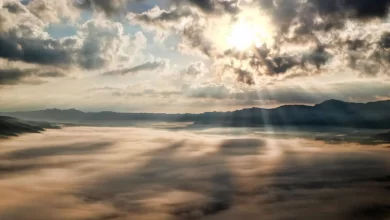Fire, a powerful chemical reaction between oxygen and a combustible material, has played a pivotal role in human history. It provides warmth, light, and a means to cook food, making it a fundamental element for survival. However, fire also poses great danger when uncontrolled, capable of causing devastation to forests, homes, and entire landscapes. Its mesmerizing dance of flames has been a source of fascination and inspiration for art, culture, and mythology throughout the ages. Firefighters and first responders bravely combat its destructive force to protect lives and property. In both its constructive and destructive aspects, fire remains an elemental force that shapes the human experience and the natural world.
- Fire Triangle: Fire requires three elements to ignite and burn: fuel, oxygen, and heat. This concept is often referred to as the “fire triangle.”
- Fire Tetrahedron: In addition to the fire triangle, modern fire science recognizes a fourth element, the “chemical reaction.” Together, these four elements make up the “fire tetrahedron.”
- Discovery of Fire: The controlled use of fire by early humans marked a significant turning point in human evolution. It provided warmth, protection from predators, and a means to cook food, which made more nutrients available and easier to digest.
- Types of Fire: There are various types of fires, including Class A (ordinary combustibles like wood and paper), Class B (flammable liquids), Class C (electrical fires), Class D (metal fires), and Class K (cooking oil and grease fires).
- Wildfires: Wildfires are uncontrolled fires that can spread rapidly through forests and grasslands. They can be caused by lightning, human activities, or a combination of factors.
- Firefighters: Firefighters are trained professionals who respond to fires and other emergencies. They use specialized equipment and techniques to extinguish fires and save lives.
- Fire Behavior: Fire can exhibit different behaviors, such as spreading through convection (heat rises), conduction (transfer of heat through direct contact), and radiation (heat transfer through electromagnetic waves).
- Color of Flames: The color of flames can indicate the temperature of the fire. For example, blue flames are hotter than yellow or red flames.
- Spontaneous Combustion: Some materials, like oily rags, can undergo spontaneous combustion when they oxidize and generate heat, eventually leading to ignition.
- Controlled Burns: Controlled or prescribed burns are intentional fires set by land managers to reduce the risk of larger, uncontrolled wildfires and to promote ecosystem health.
- Fire Safety: Fire safety measures, such as smoke detectors, fire extinguishers, and fire drills, are essential for preventing fire-related accidents and fatalities.
- Fire in Space: In microgravity conditions in space, flames behave differently. They don’t have the typical upward direction and can take on spherical shapes due to the absence of buoyancy.
- Fire-Resistant Materials: Advances in materials science have led to the development of fire-resistant and flame-retardant materials used in buildings, clothing, and equipment to reduce fire risks.
- Famous Fires: Historic fires, such as the Great Fire of London in 1666 and the Chicago Fire in 1871, have had a significant impact on urban development and fire safety regulations.
- Fireworks: Fireworks are colorful pyrotechnic displays that use controlled explosions to create dazzling visual effects in the sky.
- Fire as a Symbol: Fire has symbolic meanings in various cultures and religions, often representing purification, transformation, and illumination.
- Fire Tornadoes: Under certain conditions, wildfires can create fire tornadoes, also known as fire whirls or firenadoes. These swirling columns of flames can be extremely destructive and dangerous.
- Famous Firefighters: Notable historical figures like Benjamin Franklin and Catherine O’Leary (associated with the Chicago Fire) were famous for their firefighting efforts or connections to fire-related incidents.
- Prometheus: In Greek mythology, Prometheus is credited with stealing fire from the gods and giving it to humanity, symbolizing the gift of knowledge and civilization.
- Fire and Cultural Ceremonies: Fire plays a central role in many cultural and religious ceremonies worldwide, from lighting the Olympic flame to the Diwali festival’s lighting of lamps and candles.
- Fire Ecology: Some ecosystems, like certain pine forests, depend on periodic fires to clear underbrush and promote the germination of certain plant species. These are known as fire-adapted ecosystems.
- Fire-Resistant Trees: Some tree species, such as the giant sequoias, have adapted to withstand fires due to their thick bark and fire-resistant cones that release seeds during a fire.
- Fire in Literature and Art: Fire has been a prominent theme in literature and art, from books like Ray Bradbury’s “Fahrenheit 451” to paintings depicting historical fires and fiery landscapes.
- Fire as a Tool: Humans have used fire as a tool for various purposes, including land clearing for agriculture, cooking, and industrial processes like metal smelting.
- Fire Safety Codes: Building codes and regulations, such as the National Fire Protection Association (NFPA) standards, are developed to enhance fire safety and prevent fire-related disasters.
- Fire Extinguishing Methods: Different types of fire extinguishers are designed to combat specific types of fires. For example, water is effective against Class A fires, while CO2 extinguishers are used for electrical fires.
- Fire in Pop Culture: Fire-related imagery, characters, and special effects are common in movies, TV shows, and video games, contributing to its enduring fascination in popular culture.
- Fire and Ancient Weapons: Early humans used fire as a weapon by creating torches or flammable projectiles to fend off predators or enemies.
- Chemistry of Fireworks: Fireworks use a combination of chemicals to produce various colors. For example, strontium salts create red, barium salts produce green, and copper compounds yield blue.
- Fire-Adapted Animals: Some animals, like certain species of woodpeckers, rely on fire to create dead or decaying trees that serve as habitat for insects they feed on.





